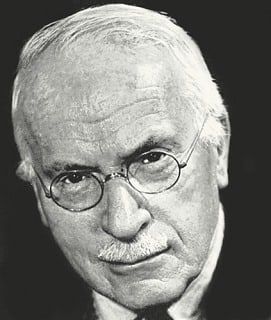 In 2009 there was one publication that dwarfed most every other in importance, uniqueness and sheer size: THE RED BOOK, a massive 18×12-inch volume by the late Carl Jung. The book was drafted back in the 1940s but kept out of sight until its first-ever public appearance last year, in an expensive hardcover edition edited and introduced by the London historian Sonu Shamdasani.
In 2009 there was one publication that dwarfed most every other in importance, uniqueness and sheer size: THE RED BOOK, a massive 18×12-inch volume by the late Carl Jung. The book was drafted back in the 1940s but kept out of sight until its first-ever public appearance last year, in an expensive hardcover edition edited and introduced by the London historian Sonu Shamdasani.
Carl Gustav Jung (1875-1961) is a pivotal figure in the field of psychology. Among his contributions were the still-prevalent theories of the Archetype and Collective Unconscious, while his belief in spirituality as an indispensable component in the understanding of and cure for psychological maladies was the indirect inspiration for Alcoholics Anonymous. Jung’s incorporation of dreams and the unconscious has also proven quite influential; filmmaker Federico Fellini apparently patterned the surreality of his films (8½, JULIET OF THE SPIRITS, FELLINI SATYRICON, etc.) after Jungian psychology. Jung is often characterized as a disciple of Sigmund Freud, another important psychological pioneer, yet while the two had a friendship spanning the years 1906-1912, Jung’s theories were very much his own.
Many of Jung’s concepts originated in childhood memories, including an odd ritual he performed on a tiny mannequin that he later learned was similar to certain ancient religious practices (apparently an early indicator of the existence of the Collective Unconscious), and an inability to do homework without fainting (his introduction to the concept of a neurosis). His principal ideas, however, were developed during the writing of THE RED BOOK, which began as a series of journals Jung kept starting in 1913.
It was that year in which Jung, aged 38, experienced the first of a lengthy succession of visual and auditory hallucinations. Initially concerned he was going mad, Jung eventually decided the visions were valuable, and took to deliberately inducing these “active imaginations.” His transcriptions of the hallucinations spanned the next 16 years, a period he subsequently termed “the most important of my life. Everything else is to be derived from this. It began at that time, and the later details hardly matter anymore.” It’s no wonder the heavily illustrated 205-page product of Jung’s visions, entitled LIBER NOVUS/THE NEW BOOK but more commonly known as THE RED BOOK (because of the red leather binding of the original manuscript), has been called “The Holy Grail of the Unconscious.”
Jung fretted over the LIBER NOVUS throughout the remainder of his life yet never finished it. The book remained unpublished at the time of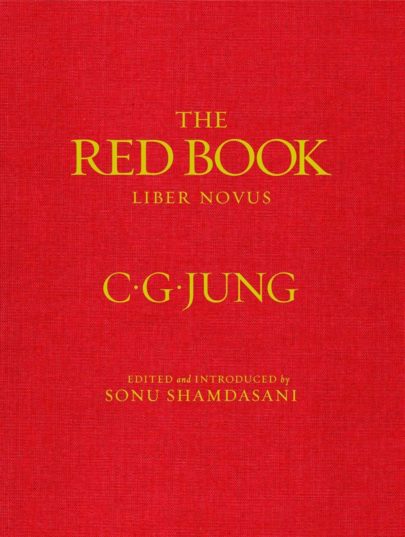 Jung’s death, and he left no instructions on what to do with it. After spending 23 years inside a cupboard at Jung’s Zurich home the manuscript was transferred to a bank vault in 1984, where it stayed for the next seventeen years.
Jung’s death, and he left no instructions on what to do with it. After spending 23 years inside a cupboard at Jung’s Zurich home the manuscript was transferred to a bank vault in 1984, where it stayed for the next seventeen years.
For decades the existence of the LIBER NOVUS was a legend among Jung scholars. Jung’s family vociferously kept the volume under wraps, apparently due to its many embarrassing personal revelations. Throughout the years many an academic, notably the book’s eventual editor Sonu Shamdasani, attempted to persuade the family to give up the goods, only to be told in no uncertain terms to (in Shamdasani’s words) “Get lost.” Eventually Jung’s grandson Ulrich Hoerni elected to bring LIBER NOVUS to light, and, following a painstaking digital scanning of the original pages at one-tenth of a millimeter at a time, W.W. Norton & Company published THE RED BOOK in October 2009.
It’s here that perhaps the oddest portion of THE RED BOOK’S history occurred: it became a bestseller.
The initial print run was restricted to 5,000 copies priced at $195.00 apiece(!), as Norton apparently didn’t feel the book had much commercial appeal. Clearly they were wrong, as interest was widespread and intense (at one point it reached the number four position on Amazon.com’s bestseller list). The book sold out months in advance of its publication, and copies of that fabled first printing are now expensive collector’s items.
This led to a mad scramble by Norton to print more copies. That was no easy task, as each book is carefully and expensively handcrafted in Verona, Italy. As a result, copies have been slow to trickle out to customers who pre-ordered the book online, to say nothing of bookstore shelves.
It almost seems like a bad joke that this dense and hermetic volume became a coffee table mainstay for yuppies. I wonder how far into the book those yuppies actually got, or if they’ve even bothered reading it at all. It’s my contention that THE RED BOOK will likely become this decade’s BRIEF HISTORY OF TIME, meaning a book that many people buy but few actually read.
_____________ _____________
Onto the book itself.
Roughly the first half of THE RED BOOK consists of sumptuous reproductions of Jung’s original calligraphic text (in German) and watercolor artwork. The minutely drafted pages resemble those of a medieval manuscript, evincing an authentic and impressive artistic talent.
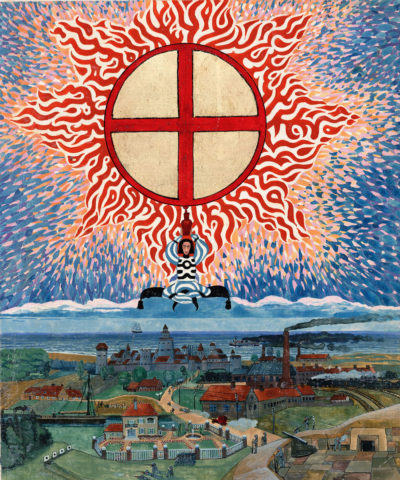 Jung’s artwork has a strange alchemical beauty. The impeccably drafted primitivism of the paintings often recalls William Blake, with boldly rendered flames, demons and serpents predominating over swirling psychedelic backgrounds. At other points Jung fills entire pages with astonishingly detailed mandalas (Eastern-inspired concentric diagrams that Jung viewed as representations of the unconscious) and the obligatory (to anyone who’s attempted to read the text) religious iconography.
Jung’s artwork has a strange alchemical beauty. The impeccably drafted primitivism of the paintings often recalls William Blake, with boldly rendered flames, demons and serpents predominating over swirling psychedelic backgrounds. At other points Jung fills entire pages with astonishingly detailed mandalas (Eastern-inspired concentric diagrams that Jung viewed as representations of the unconscious) and the obligatory (to anyone who’s attempted to read the text) religious iconography.
Following this is a brief but detailed Jung biography by Sonu Shamdasani, and then the English translation of the manuscript, complete with extensive Shamdasani-penned footnotes. It makes me wish I knew German, as the original calligraphic text in conjunction with the illustrations is clearly the optimum reading experience.
Anguished and Hellishly complex, the text of THE RED BOOK is as dense and confounding as anything I’ve read, a tortured morass of druggy hallucination and spiritual rumination. It’s akin at times to De Quincy’s CONFESSIONS OF AN ENGLISH OPIUM EATER, and at others to surreal literature. Of course surrealism isn’t necessarily meant to be understood, whereas Jung’s every utterance has a very definite interpretation. Jung is always careful to elucidate the meanings of his imagery, but ultimately it’s up to the reader to make his/her own way through this epic dreamscape.
What follows is my admittedly facile summary of the text, which is anything but straightforward—Shamdasani has admitted it took him years to “feel as if he understood anything” about THE RED BOOK. Obviously I haven’t spent nearly as much time with it, and so my understanding is limited.
The book is divided into three parts (whether Jung intended them as three separate volumes or parts of a whole is something even Shamdasani is unclear on). First up is “Liber Primus” and the earliest of Jung’s visions, of a vast flood and a sheet of ice crashing to Earth.
These images evolve into more detailed and inclusive psychoscapes as Jung learns to abandon rationality and give himself over fully to the unconscious. He spends several days in a sweltering desert (a la St. Anthony) and then descends into Hell, populated by serpents and a stream of blood. He’s careful, of course, to delineate what these things represent: the desert is the parched landscape of Jung’s self that can be made to bloom only through a reconciliation with the soul, while the serpents of Hell convey a dire warning to “Heal the wounds that doubt inflicts.”
Many if not all of the visions Jung describes are redolent of the collective rather than singular unconscious, which explains the constant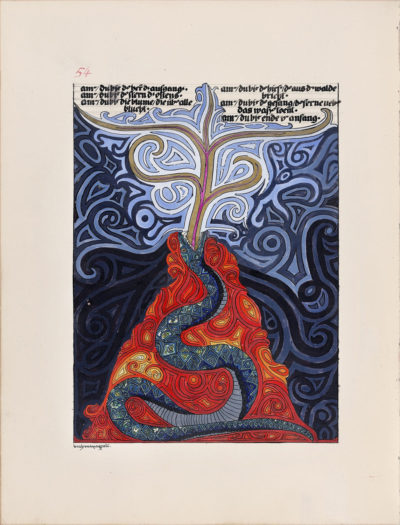 references to popular figures (at one point Jung murders Siegfried) and Jesus Christ (whose life and teachings figure throughout). It’s from the collective unconscious, apparently, that the Biblical prophet Elijah and his daughter Salome emerge to lead Jung through his visionary netherworld. Salome is actually Jung’s sister—which complicates things mightily when he finds himself becoming attracted to her—and identifies their mother as the virgin Mary. As for Elijah, he represents divine insight, and evolves into the mythic figure Philemon, or, as rendered here (in its original Greek wording), ΦΙΛΗΜΩΝ.
references to popular figures (at one point Jung murders Siegfried) and Jesus Christ (whose life and teachings figure throughout). It’s from the collective unconscious, apparently, that the Biblical prophet Elijah and his daughter Salome emerge to lead Jung through his visionary netherworld. Salome is actually Jung’s sister—which complicates things mightily when he finds himself becoming attracted to her—and identifies their mother as the virgin Mary. As for Elijah, he represents divine insight, and evolves into the mythic figure Philemon, or, as rendered here (in its original Greek wording), ΦΙΛΗΜΩΝ.
This brings us to the second and lengthiest portion of the text, “Liber Secundus,” which begins with Jung in a solitary countryside. There he’s approached by a red-hued horseman who is in fact the Devil, and the two engage in an intense spiritual debate. After further discussions with other individuals touching on scripture and the nature of masculinity, Jung penetrates the realms of death and birth.
He heads eastward, where, inspired by the figure of Izdubat the bull man, Jung explores the vagaries of Eastern religion. He then conjures God through a series of obscure incantations, ending up with a deity trapped inside an egg. Jung breaks the egg and so unleashes “My God,” but allows that “I still did not know what it means to give birth to a God.” He finds out what birthing a God does mean upon approaching the mutilated corpse of a girl: on the orders of a mysterious hooded woman he devours the dead girl’s liver. This, Jung makes clear, is based on ancient beliefs that such acts “brought healing to the soul.”
If all this sounds nutty, rest assured that Jung is fully aware of this. His soul (a separate entity from his physical self) approaches Jung one night and implores him to “recognize your madness and welcome it in a friendly manner…” Jung resists, and so finds his existence fraught with doubt and uncertainty. “Am I asleep or awake?” he ponders, “Am I alive or have I already died?”
Jung’s travails inspire him to find a magician, as “Whoever cannot find (magic) within himself should become an apprentice.” The magician is none other than ΦΙΛΗΜΩΝ, who informs Jung that magic is beyond his understanding because “Magic accords with unreason, which one cannot understand.” In other words, a reasonable man has no use for magic.
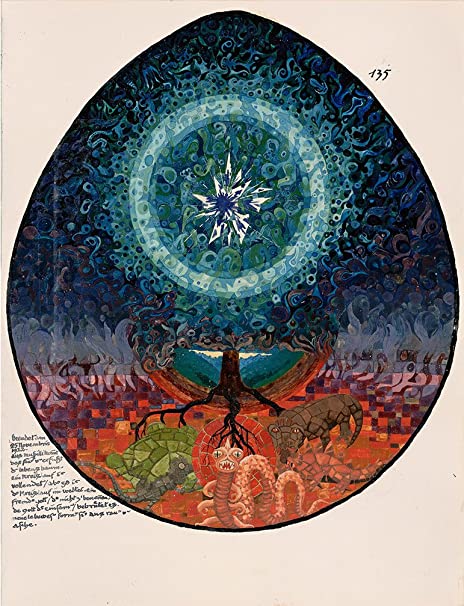 By this point it seems there’s just one place left to go: the throne of God. There Jung confronts Satan once again. Being most comfortable in the underworld, Satan doesn’t hang around long, leaving Jung in the company of misshapen spirits emanating from his body known as Cabiri. The Cabiri give Jung a sword with which to chop them up, and so free himself from worldly concerns. This he does, and is confronted with a huge tower representing the vastness of Jung’s soul, solidified after resisting the minions of Hell.
By this point it seems there’s just one place left to go: the throne of God. There Jung confronts Satan once again. Being most comfortable in the underworld, Satan doesn’t hang around long, leaving Jung in the company of misshapen spirits emanating from his body known as Cabiri. The Cabiri give Jung a sword with which to chop them up, and so free himself from worldly concerns. This he does, and is confronted with a huge tower representing the vastness of Jung’s soul, solidified after resisting the minions of Hell.
But all is not right. There follows a further anguished meeting with ΦΙΛΗΜΩΝ and Salome that concludes with Jung crucified and taunted by Satan. The latter leaves with a prophetic warning: “This is only the beginning.”
The third and final (picture-less) portion of the RED BOOK is “Scrutinies.” Here Jung finds himself alone with “I,” who initially berates him as a selfish exploiter of others. Also present is Jung’s soul, a feminine presence who’s far less abrasive than “I” but still quite firm. “Did I not predict dark solitude for you?” his soul admonishes, cautioning that resisting such solitude is “utterly hopeless.” This sends Jung into a funk that lasts until the outbreak of WWI, when Jung’s soul informs him that “The greatest comes to the smallest”(?).
Inconclusive though it seems, that utterance is apparently so profound it silences the “voices of the depths” for a year, until one day Jung’s soul pipes back up and he’s harassed by ΦΙΛΗΜΩΝ. He’s plunged back into doubt and despair, tormented by familiar (to anyone who’s read the rest of the book) queries about love and divinity.
Jung is confronted with the realities of the Pleroma, the Gnostic state of nothingness—or fullness, as “That which is endless and eternal has no qualities, since it has all qualities.” This leads to a recitation of pre-Christian polytheistic beliefs by a pontificating ΦΙΛΗΜΩΝ, much to the consternation of his audience, a crowd of ghouls identified as, simply, the Dead. They sternly reject his teachings, but that doesn’t stop the Dead from returning each night to hear ΦΙΛΗΜΩΝ sermonize, which he does seven times. At the end of the final sermon the dead evaporate, making way for a new presence: Death, of whom ΦΙΛΗΜΩΝ warns Jung, “You will be hearing from him.”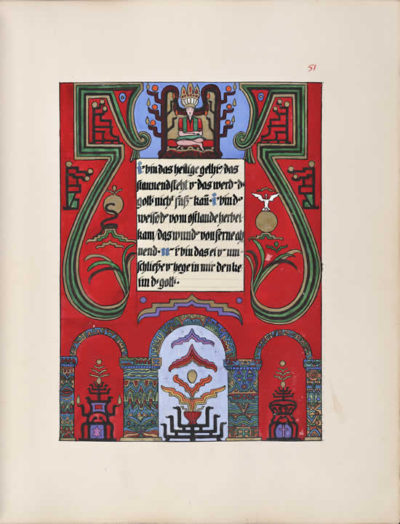
There follows a last dream-visit by Elijah (prior, it seems, to his incarnation as ΦΙΛΗΜΩΝ) and Salome, and another lengthy discussion about the nature of divinity. It concludes with Jung electing to turn his back on the dictates of the gods (having already rejected the idea of a single deity), which freaks out his soul considerably, and closes the book out on a conflicting note.
The final page is a brief 1959-penned epilogue in which Jung concedes he was unable to finish his opus but felt compelled to transcribe it nonetheless: “I always knew that these experiences contained something precious, and therefore I knew of nothing better than to write them down…and to paint the images that emerged through reliving it all…” It seems curiously appropriate that, after a few more lines, the text doesn’t conclude so much as cut off in the middle of a sentence.
